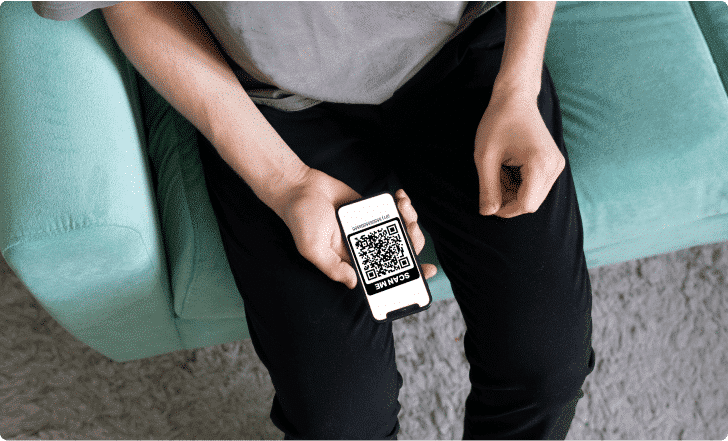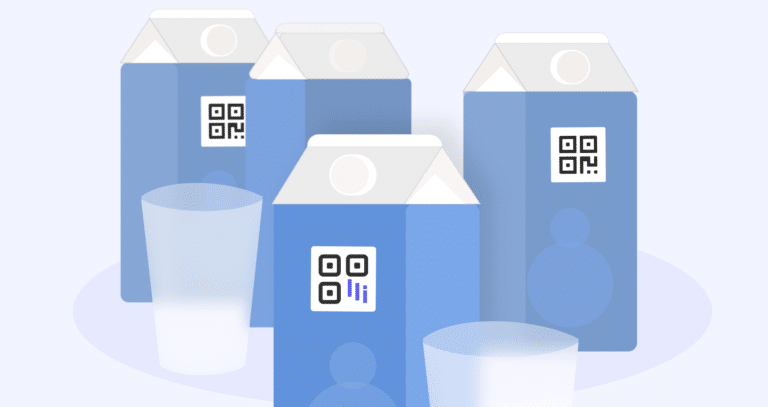QR codes have come a long way—and digital link QR codes mark a major leap forward. Built on the GS1 digital link standard, these next-generation codes don’t just point to a single static page. They unlock a dynamic, structured stream of digital information designed for real-world use: detailed product data for curious consumers, streamlined tracking for supply chain partners, and seamless integration for point-of-sale systems and business partner APIs.
In a world where physical products need to speak the language of the web, digital link QR codes make that possible—bridging the gap between brands, consumers, and trading partners like never before.

What’s a digital link?
A digital link is more than just a web address—it’s a smart way to connect physical products with the digital world. At its core, it’s a URL that includes a product’s unique identifier, following the GS1 digital link standard set by GS1, the global authority behind barcodes and product data standards.
This new standard takes traditional barcodes to the next level. It embeds structured data into a scannable format, turning simple QR codes into powerful gateways for sharing detailed information. Whether you’re a brand owner sharing consumer-facing applications, or a manufacturer coordinating data with trading partners, digital link QR codes create a flexible, standards-based structure that works across the supply chain.
By making barcodes data carrier agnostic, the GS1 digital link standard supports multiple types of codes—QR, Data Matrix, linear barcodes, even NFC tags—while delivering more product information in real time. It’s not just about identifying a product anymore; it’s about creating a digital handshake between businesses, systems, and consumers.
The URI structure: an augmented web address
At the heart of digital link QR codes is a smart URI—a web address that includes product identifiers like the global trade item number (GTIN). This structured format makes it possible to share additional data like batch numbers or expiry dates in a single, scannable link.
The role of resolvers
Resolvers are servers that interpret the URI and deliver the right digital content. They check if the product identifiers are valid and then direct users to a brand-owned web page, product info, or business-to-business documentation—based on factors like location, device, or time of scan.
One code, many uses: from point-of-sale systems to consumer engagement.
Encoding into data carriers: why a QR code is better
To bring the digital link to life, it needs to be printed on a product as a QR code or Data Matrix. QR codes are ideal—they’re widely recognized, easy to scan, and work across both consumer and business environments.
Future-proofing with GS1 digital link QR codes
GS1’s Sunrise 2027 deadline is pushing brands to move from linear barcodes to digital link QR codes. Starting now helps businesses stay compliant, improve supply chain visibility, and deliver richer consumer experiences—all with a single barcode.

Applications across industries
GS1 digital link QR codes are transforming how businesses share information—across every sector.
Retail and consumer goods
From product packaging to promotions, digital link QRs give consumers instant access to sourcing details, manuals, recipes, or loyalty sign-ups. At the same time, retailers gain real-time inventory insights.
Healthcare
QR codes on medication packaging improve patient safety by linking to dosage info, expiration dates, and compliance data. Hospitals also use them to track equipment and manage maintenance.
Food and beverage
Digital links enable full traceability—farm to table. Shoppers get clear nutritional info and allergen warnings, while brands can manage recalls quickly and efficiently.
Manufacturing
Track products from production to sale, ensure regulatory compliance, and give partners instant access to structured data like certifications or serial numbers.
Fashion and apparel
Fight counterfeits and build trust by showing sustainability practices and verifying product authenticity via a quick scan.
Technology and electronics
Digital link QR codes connect users to setup guides, software updates, and product features—right from the device.
No matter the industry, digital link QR codes deliver smarter, faster access to the right data—boosting consumer engagement, compliance, and supply chain visibility.
Compliance with regulations
Digital link QR codes are becoming essential tools for regulatory compliance. They help businesses share accurate, structured data with both consumers and authorities—right from the product packaging.
European Digital Product Passport (DPP)
Part of the EU’s circular economy push, the Digital Product Passport requires products to disclose lifecycle data—from production to recycling.
Digital link QRs make this simple: scan the code, and access repair history, sustainability claims, or materials used—all tied to the same code on the label.
EU Regulation 2021/2117 on wine labels
Wine producers must now provide more detailed product information under this regulation. With a digital link QR code, they can go far beyond space-limited labels—sharing origin details, ingredients, vineyard info, and even food pairings in the user’s preferred language.
From sustainability to transparency, digital link makes compliance more than a checkbox—it becomes part of the consumer experience.

FDA Nutrition Facts Label in the U.S.
In the U.S., the FDA requires food and beverage packaging to include key nutritional information. Digital link QR codes take this further—offering a dynamic way to share calories, ingredients, allergens, and even dietary guidance.
A quick scan gives consumers access to more detailed product information than what fits on a physical label, all while keeping brands compliant with FDA standards.
Across industries, digital link QR codes simplify regulatory compliance by turning a barcode into a live source of accurate, trusted information—strengthening consumer safety, transparency, and brand loyalty in the process.
Enhancing brand engagement and customer experience
Digital link QR codes create a lasting connection between brands and consumers—starting at the point of sale and continuing long after. This ongoing interaction boosts customer satisfaction and strengthens brand loyalty.
Interactive and personalized marketing
Scanning a digital link can unlock tailored content, offers, or updates based on the user’s location, preferences, or purchase history. It’s a simple way to keep your brand top-of-mind—long after the product is in their hands.
Enhanced product use and satisfaction
By scanning a digital link QR code on a product, customers can access how-to guides, video tutorials, and troubleshooting tips, enhancing their product usage experience.
Brands can encourage customers to leave feedback or reviews, improving product and customer satisfaction.
Smarter product experiences
From video tutorials to troubleshooting tips, digital link QRs give customers everything they need to enjoy and understand your product. Brands can also collect feedback or reviews, improving both product quality and consumer engagement.
Seamless loyalty and rewards
With one scan, customers can join loyalty programs, access special deals, or unlock exclusive content—no apps or signups required. It’s instant, and it strengthens brand-owned web connections.
Customer insights in real time
Every scan tells a story. Digital link makes it easy to gather data on consumer behavior and adjust content dynamically—offering more relevant, more effective experiences.
In short, digital link QR codes turn packaging into a platform for personalized engagement, helping brands deliver value before, during, and after the sale.
Improving supply chain management
Integrating digital link QR codes into supply chain systems transforms how businesses track, manage, and optimize product flow. With a single scan, manufacturers, distributors, and retailers can access structured data tied to each product—enhancing transparency and operational control.
Real-time tracking and visibility
Digital link QRs allow for granular tracking of individual items across the entire supply chain, from factory floor to final delivery. This real-time insight helps reduce misplacements, avoid delays, and improve coordination between trading partners.
By improving supply chain visibility, digital links empower businesses to quickly identify bottlenecks, address disruptions, and respond proactively. They also enable better forecasting and inventory management, helping avoid overstocking or out-of-stock scenarios.
Streamlined communication and data sharing
Thanks to the GS1 digital link standard, brands can share additional data—like serial numbers, batch numbers, or compliance documents—through a standardized, structured format. This simplifies communication with business partner APIs and improves integration across different systems.
In an increasingly connected logistics landscape, digital link QR codes offer a scalable, standards-based solution that enhances accuracy, traceability, and performance from end to end.

Efficient inventory management
Digital link QR codes give businesses real-time visibility into inventory levels, helping them strike the right balance between supply and demand. With accurate, up-to-date data, companies can forecast more effectively and schedule replenishments with confidence—reducing both overstocking and stockouts.
Each scan provides a snapshot of product movement, allowing brands to adapt quickly to shifting market demands. This level of agility is essential for maintaining service levels while optimizing storage and production costs.
Product safety and recall management
When recalls happen, speed matters. Digital link QRs allow instant identification of affected products through batch numbers or serial numbers encoded in the QR code. Brands can quickly remove items from the supply chain, minimizing consumer risk and limiting financial damage.
This traceability also builds trust. Consumers and trading partners can rely on accurate, up-to-date information about product safety and status—directly from the packaging.
Sustainability and environmental impact
Digital link technology supports sustainability efforts by improving resource efficiency and reducing waste. Businesses can track environmental impact metrics throughout the product lifecycle, making it easier to monitor progress and report on ESG goals.
By embedding data on product composition, recyclability, or return programs, brands can empower consumers to make informed, sustainable choices. This aligns with circular economy principles and strengthens environmentally-conscious brand positioning.
Data-driven decision-making
Every interaction with a digital link QR code generates structured data that feeds into smarter decision-making. From supply chain performance to product usage trends, brands can analyze scan behavior to uncover inefficiencies, optimize operations, and improve customer experiences.
With digital link, supply chain decisions aren’t based on guesswork—they’re grounded in real-time data.
Conclusion
Digital link QR codes mark a major leap forward in how product information is shared, verified, and experienced. When combined with dynamic QR codes, they unlock powerful capabilities—from regulatory compliance and real-time tracking to personalized consumer engagement and smarter supply chain operations.
If you manufacture or trade physical products, the time to act is now. The global shift from UPCs and linear barcodes to digital link QRs is already underway, with GS1’s Sunrise 2027 deadline fast approaching. And with the EU’s Digital Product Passport initiative gaining momentum, digital links aren’t just a nice-to-have—they’re a strategic necessity.
To learn more and start implementing digital link QR codes, visit digital-link.com—your gateway to resources, tools, and guidance for the next generation of product connectivity.







